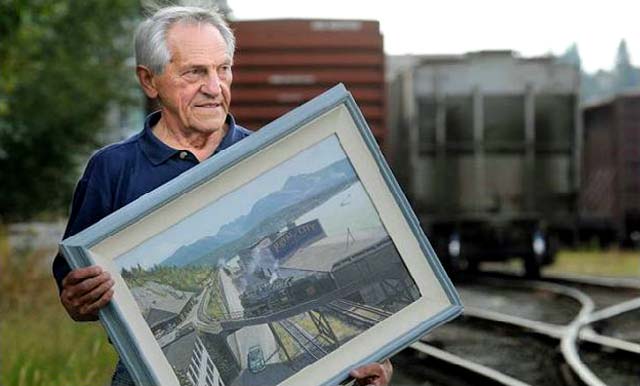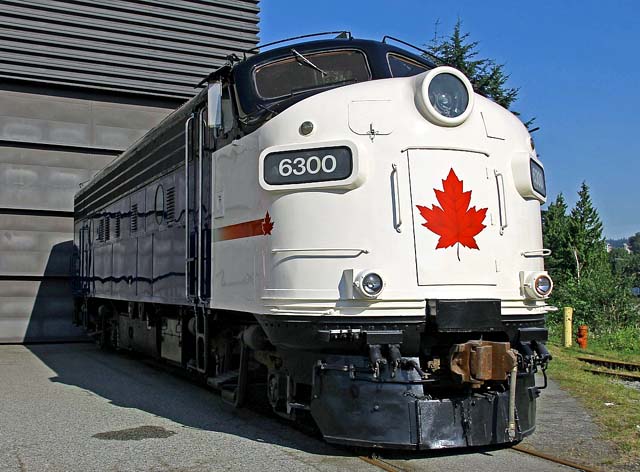
2012
|


Max Jacquiard holds one of his many paintings - Date/Photographer unknown.
31 August 2012
Train Master
New Westminster British Columbia - Max Jacquiard was 17 in 1951 when he went to work in the rail yard of Pacific Great Eastern,
predecessor to BC Rail, in Quesnel. He didn't last much more than a week. The job just wasn't for him.
So for someone so resistant to working the rails it's a bit strange he's a member of the Canadian Railway Hall of Fame. He's there for good reason, though.
He was inducted because of a talent that tugs at the heartstrings of those with locomotives running through their blood.
The New Westminster resident has been painting since the 1970s. That's not special. What is special, is for the last three decades the paintings all have
trains in them, and those works are treasured possessions of those with rails in their DNA.
Many of his best works have been put together in a collection by author Barrie Sanford entitled "Train Master: The Railway Art of Max
Jacquiard", which will launch on Saturday, 8 Sep 2012.
Jacquiard's early formative years were spent in Northern Manitoba near the Saskatchewan border. The family with a Swiss-French heritage lived in a log cabin
built during the Depression on Ross Lake on the opposite side to the mining town of Flin Flon. The end of a Canadian National Railway branch line ran alongside
the lake just a few hundred yards from their cabin.
He would watch in fascination as the steam engines chugged by, their parts moving in percussive synchronicity complete with bells and whistles.
"They were almost alive compared to the diesel locomotives of today," says the 78-year-old Jacquiard. "It's hard to explain. There were the
smells of them, the steam had a smell. They've got grease, and the motion of the rods, and pistons, and the sounds."
The family moved to B.C. to get away from the prairie wicked winters when he was nine. After moving around the province, he eventually went to work for
Smith-Reid Printing on Agnes Street in New Westminster. In 1973, he got restless and decided to take up painting as a hobby. After all, his school notebooks
were littered with cartoons he doodled during class. He'd do them on the corner of each page creating a little movie when he flipped through them.
At first he painted subjects like landscapes. To learn more about the craft, he went to night school, but that didn't last long. His instructors didn't believe
his art would be desirable because they were so detailed and not artistic.
"I like to be as realistic as possible and we weren't encouraged to paint that way at all," says Jacquiard. "They had me do bowls of fruit and
flowers, and they wanted very loose and very broad brush strokes. I thought, this doesn't appeal to me, I'll just do it my way."
Doing it "my way" turned out to be as good a decision as Frank Sinatra to sing the song penned by Paul Anka.
Jacquiard hit upon his specialty in 1981 when he hopped in his car and headed to the Rockies on a vacation.
"I set out to play golf for a week or so and I wound up following the railway lines and taking pictures," says Jacquiard. "I played one game in
Banff."
Seeing the tracks brought back those CNR branch line memories of his youth, and he was inspired.
"I thought it would be neat to do a bunch of train paintings and maybe eventually have some kind of exhibition. People seemed to like them and I sold the
odd one or two," says Jacquiard.
Almost 400 paintings later it would seem he is on to something.
His works depict the steam era. They're evocative of idyllic days and time gone by in British Columbia, full of colour, sentiment, and scenery.
In the introduction to "Train Master", Sanford tells of how at a meeting of old railroaders he was fascinated looking at an image from about 20 feet
away. He recognized the location instantly, a Canadian Pacific Railway passenger train crossing the Columbia River Bridge at Revelstoke, but thought it was a
photograph. But that didn't make sense because he couldn't figure out how the photographer managed to get the vantage point to take such a magnificent picture.
"Then I overheard someone say "painting" and I surged forward in disbelief," wrote Sanford. "Instantly I was struck by the
unbelievable clarity of the image and richness of the colour."
Sanford said the painting was authentic right down to the Walschaerts valve gear.
Jacquiard has been taking his works to gatherings of train lovers around Western Canada for decades.
"I'm trying to paint these things as they were, and that was when it was mostly, or still all steam," he says. "I've painted the odd diesel, but
they don't have the same appeal to me."
The love of his life for 27 years, Gloria Dent, says she watches in amusement when train lovers look at Jacquiard's paintings for the first time.
"They're quite in awe of his detailing," says Dent in their Quayside condo. "Many of them have tears in their eyes. He does have quite a
following of people."
So many, in fact, that in 2006, he was inducted into the hall of fame. "I was surprised and flattered," says the shy and humble Jacquiard.
He paints six days a week and averages about 10 works a year, although he used to produce about 15 annually. He keeps meticulous records of each painting, but
hasn't gone to the trouble of counting them up, although he figures the total is about 390 ("I destroy the odd one"). There's even a few he's done
depicting New Westminster's railway history.
Sanford, who Jacquiard has collaborated with before on other books including "Railway by the Bay: 100 Years of Trains at White Rock, Crescent Beach,
and Ocean Park", called last January asking to put his work into a compendium.
The result is "Train Master", a colourful, informative, 160 pages of the province's transportation yesteryear, published by the National Railway
Historical Society, British Columbia chapter. The book's launch, which contains 100 of Jacquiard's images, will be on 8 Sep 2012.
Grant Granger.
Editor's Note: Space is limited. As such, this is an RSVP event. If you'd like to attend to meet these fine gentlemen and see the equipment,
please contact Terry Fergusson directly at fergussontrain@gmail.com to make a reservation to attend, and for instructions on accessing the secured site.

The British Columbia Chapter of the National Railway Historical Society's locomotive number 6300 should be on
display at the Braid Street location - 6 Jul 2012 Andy Cassidy.

|


|
Vancouver Island
British Columbia
Canada
|
|


